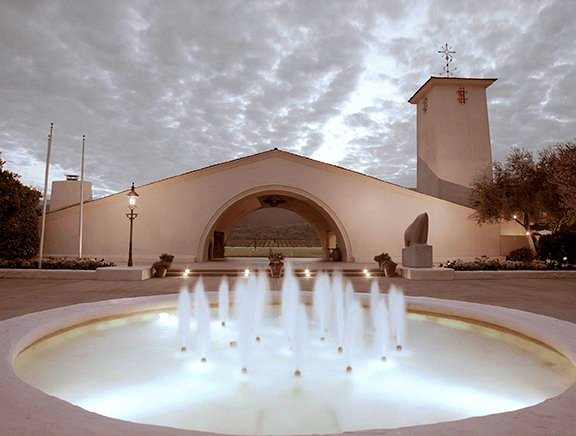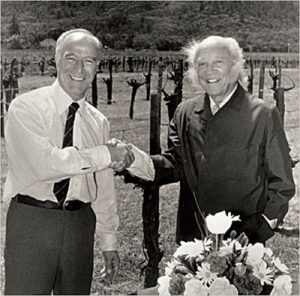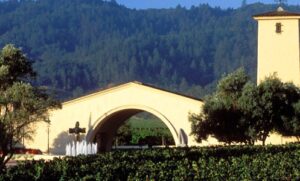2013 Robert Mondavi Winery Cabernet Sauvignon Reserve To-Kalon Vineyard Oakville California USA Wine Tasting Note
5559 Views
|
2013
Robert Mondavi Winery Cabernet Sauvignon Reserve To-Kalon Vineyard (Oakville)
This is a beauty. It has richness, perfectly ripe, dark red fruits, lush, round, polished tannins and the structure to age for 2-3 decades. Still young, yet everything is so soft, it is already far too easy to enjoy, and the best is yet come. That is, if you can wait for at least a decade or more. 5,559 Views Tasted Dec 14, 2017 |


Everything about Robert Mondavi Vineyards, Napa Valley California Cabernet Sauvignon wine producer profile, wine tasting notes, wine and food pairing tips, best vintages, history of the property, information on their wine making techniques, terroir and soil. You can also read about the Grapes used for California wine and learn about the extensive History of Napa Valley, California Wines
Robert Mondavi Winery History, Overview
While the Robert Mondavi story starts with his birth in 1913 in Virginia Minnesota, the history of the Mondavi family in the California wine industry begins with their first purchase in Napa Valley in 1934, which was the Sunny St. Helena Winery, which has since changed names to Merryvale.
The land was purchased from John Poggi. John Poggi was the direct descendant of Joseph Ghisletta, who first cultivated the vineyards in 1874. The Sunny St. Helena winery changed names to Muther Winery, under the ownership of the Mondavi family.
This was followed in 1943 when the Charles Krug winery sold their estate to the patriarchs of the Mondavi family, Cesare Mondavi and Rosa Mondavi for $75,000.
In a few short years following the conclusion of World War 2, Peter Mondavi ushered the modern age into their Charles Krug winery when they became one of the first wineries in the Golden State to begin replanting their vineyards with Cabernet Sauvignon and started to produce wines made from 100% Cabernet Sauvignon.
That might not sound special to you today. But it's important to note that at the time, very little Cabernet Sauvignon was planted in Napa Valley.
By the late 1940's Charles Krug was producing Cabernet Sauvignon wines as well as a Bordeaux blend known as Claret.
The Mondavi family also pioneered the use of techniques like cold fermentation and producing a special Vintage Selection bottling at Charles Krug, known as Charles Krug red stripes, due to the bright red stripes on the label Charles Krug also deserves credit for becoming one of the first California wineries to begin aging their wine in new, French oak barrels starting in 1963.
The history of Charles Krug and the entire California wine industry changed after Peter Mondavi and Robert Mondavi had a massive fight. That fight caused Robert Mondavi to quit the family business and build his own family empire as a wine maker.
In 1965. Robert Mondavi founded his winery in Oakville with 2 partners, Ivan Schoch and Fred Holmes. Their initial purchase consisted of 12 acres of vineyards that were owned by the Stelling family.
Those acres are now used for the winery, cellars and offices at the estate. Believe it or not, this was the first new winery built in the Napa Valley since Louis Martini constructed his estate back in 1933!
It was a massive undertaking for Robert Mondavi at the time. His efforts and pioneering ideas on the production, as well as the sales, distribution and promotion of the California wine industry changed everything.
Prior to Robert Mondavi, few wines were sold as a specific grape varietal. Although Cabernet Sauvignon was sold under that name by his families winery, Charles Krug, the concept of focusing on specific grapes for a wide range of grapes was the brain child of Robert Mondavi.
In 1968, Ivan Schoch and Fred Holmes sold their shares in the fledgling Robert Mondavi winery to the Rainier Brewing Company. Robert Mondavi quickly took his profits and acquired 230 more acres of the To-Kalon vineyard.
[caption id="attachment_21847" align="alignleft" width="300" caption="The Founders of Opus One"] [/caption]
[/caption]
Robert Mondavi soon began to create his own winery with his stated goal of making wine that could compete with the best wines from Europe. It was the first truly large, venture created in California since prohibition. The fruit source came from the now famous, To Kaylon Vineyards in Oakville.
In their formative years, growth of The Robert Mondavi Winery was aided by the young Michael Mondavi and the powerful, Rainier brewing company. In the early days, Robert Mondavi Winery produced wine from a myriad of grapes including Cabernet Sauvignon, Chardonnay, Riesling, Zinfandel, Gamay, Petite Sirah and Sauvignon Blanc, which Mondavi renamed Fume Blanc. By the 1970's, the winery began focusing on its core wines made from Cabernet Sauvignon and Chardonnay.
While the 1970's was a growth period for The Robert Mondavi Winery, it was a difficult time financially. Robert Mondavi was losing money.
A lot of money for the time. The lawsuit between Robert Mondavi and his families winery, Charles Krug also made its way to the courtroom. The decision in 1976 ended in Robert Mondavi's favor.
Robert Mondavi was awarded a much needed cash infusion of more than $500,000 and more importantly, on a personal basis, the judge wrote that Robert Mondavi had acted with honor, while his brother Peter Mondavi had not.
The judge ordered the sale of the Charles Krug winery. However, the brothers reached their own settlement and in 1978, Peter Mondavi bought out Robert Mondavi. Part of the settlement between the brothers also transferred the ownership of the To Kaylon vineyards holdings to Robert Mondavi.
That was a major turning point for the winery and Robert Mondavi because this gave enough money to Robert Mondavi to let him buy out his partners. And more importantly, additional vineyard land from the original to Kalon vineyards and other great terroir in Oakville were not the property of Robert Mondavi, due to the settlement the brothers reached.
Robert Mondavi Vineyards, Wines, Winemaking
The new infusion of funds allowed Robert Mondavi to add to his vineyard holdings in the To Kaylon vineyards and obtained additional land in Oakville, Stags Leap District and Carneros. There was no looking back for robert Mondavi from that day on.
[caption id="attachment_21844" align="alignleft " width="300" caption="Robert Mondavi Winery"] [/caption]
[/caption]
Robert Mondavi was one of the first wineries to popularize the production of a Reserve Wine. The first vintage using the reserve designation for their Cabernet Sauvignon was in 1968.
The rapid success of The Robert Mondavi Winery during the next several years was capped by the partnership between two famous families, the Mondavi family from Napa and the Rothschild family from Bordeaux.
Robert Mondavi and Philippe Rothschild owner of the famous Chateau Mouton Rothschild formed a partnership to produce a Bordeaux styled blend in Napa. Opus One made its debut with the 1979 vintage.
The historic partnership between Robert Mondavi and Baron Philippe Rothschild of Chateau Mouton Rothschild that created Opus One allowed for greater access to the world market for California wines. Much of the grapes used for Opus One were planted in the original To Kalon vineyard.
It's interesting to note that even though Robert Mondavi was well aware that fruit from the To Kalon vineyard was the heart and soul of their Cabernet Sauvignon, it took until 1987 to register the name, and almost another decade before he began using the To Kalon name for Robert Mondavi wines.
This is logical, because at the time, the brand name of Robert Mondavi was important to selling their wines. Mondavi meant quality. Today, consumers, especially in the high end of the market place value the terroir and the vineyards where the grapes are grown.
The next important strategic alliance for Robert Mondavi with a European winery came in 1999, when Mondavi purchased a stake in Tenuta dell' Ornellaia. Ornellaia came with close to 200 acres in the region of Tuscany. In 2002, Mondavi bought the remaining shares of Ornellaia.
The remainder of the 1980's was a strong period of growth for Robert Mondavi. This was followed by what many people believe was the best period for the Robert Mondavi Winery, 1990 to 1997. The wines produced during those years rank with some of the top wines produced by any of the best vintners in California.
The 1991 as well as the 1994 Robert Mondavi Reserve Cabernet Sauvignon remain stunning wines after close to 20 years of age. With the 1995 vintage, Robert Mondavi began using the To Kaylon vineyard designation for his Fume Blanc labeling it, "To Kalon I-Block Reserve," in honor of the vines being planted 50 years ago by Martin Stelling.
With the next vintage, they released their first To Kalon vineyard designated wine, 1996 Robert Mondavi Cabernet Sauvignon To Kalon Vineyard.
The next chapter of the winery did not fare as well. Several decisions made by some family members lessened the quality of the wine being produced, which hurt the brand in the marketplace.
Mondavi became a public company, which while on the surface, appeared to be a good business decision, forced the brand to spend more of their time on business while less of their energy was spent on what made them special in the first place, the wines of Robert Mondavi.
In 1993, Robert Mondavi Winery went public. While this might have been a good move, as it made it the family truly wealthy, it was also the beginning of the end for the Robert Mondavi Winery as we know it.
Tim Mondavi, the younger son was placed in charge of wine making. His desire to change the way the wines were made was not a success. The fruit was not picked at the same level of ripeness and because of that, the wines were not as rich, fleshy or interesting.
In interviews, Tim Mondavi was quoted as saying he was striving to produce wines that were easier to enjoy with meals. The market place did not react well and the brand continued to fall from favor. Adding to that was the focus on the branded wines like Woodbridge coupled with the lack of attention being paid to their supposedly best wines.
The valuable name of To-Kaylon eventually brought about contentious law-suits between Andy Beckstoffer and the Robert Mondavi winery, regarding the legal rights of placing the name on wine labels. The first suit was filed in 2002 By Robert Mondavi against Schrader, who filed a counter suit. This was followed by another suit by Andy Beckstoffer against Robert Mondavi.
The suit was settled with Andy Beckstoffer winning the rights to allow wineries the use the name To Kaylon on their wines. By 2016, perhaps 20 different wineries were able to by grapes from To Kalon. In theory, every winery must state the Beckstoffer To Kalon vineyard designation on the wine label.
It was an interesting development for a vineyard that Robert Mondavi did so much to develop, as he owned so many acres of the vineyard. Perhaps for the first time, Robert Mondavi did not see the future correctly, as he did not understand the consumers connection to the vineyards and terroir, over the winery. This train of though was wrongly followed by Constellation Brands as well.
Eventually the continuous public feuding among family led to the Mondavi family losing control of the board of directors for the company they created. Finally, things came to an end when the decision was reached to sell the Robert Mondavi Winery to Constellation Brands in December 2004 for one billion dollars.
That was a fortune. But it was also a huge loss to the reputation of one of the greatest brands, from perhaps the best known, and respected figure to come from Napa Valley, Robert Mondavi. Robert Mondavi passed away at the age of 94, May 16, 2008.
Serving and Decanting Robert Mondavi wines with Wine, Food, Pairing Tips
Robert Mondavi wines are best served at 15.5 degrees Celsius, 60 degrees Fahrenheit. The cool, almost cellar temperature gives the wine more freshness and lift. Young vintages of their red wine can be decanted for 1-3 hours, depending on the character of the vintage. This allows the wine to soften and open its perfume. Older vintages might need very little decanting, just enough to remove the sediment.
The red wine of Robert Mondavi is best served with all types of classic meat dishes, veal, pork, beef, lamb, duck, game, roast chicken, ribs, hamburgers, barbecue, roasted, braised, grilled dishes and stews. Robert Mondavi is also good with Asian dishes, hearty fish courses like tuna, salmon, mushrooms and pasta.
The white wine of Robert Mondavi is best served with all types of seafood and shellfish, sushi, sashimi, chicken, veal, pork and cheese.

